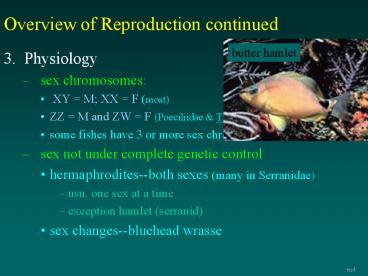Overview of Reproduction continued - PowerPoint PPT Presentation
1 / 33
Title:
Overview of Reproduction continued
Description:
ZZ = M and ZW = F (Poeciliidae & Tilapia spp) some fishes have 3 or more sex chromosomes ... bullhead--both sexes. smallmouth bass--males. end. end. Sensory Perception ... – PowerPoint PPT presentation
Number of Views:71
Avg rating:3.0/5.0
Title: Overview of Reproduction continued
1
Overview of Reproduction continued
- 3. Physiology
- sex chromosomes
- XY M XX F (most)
- ZZ M and ZW F (Poeciliidae Tilapia spp)
- some fishes have 3 or more sex chromosomes
- sex not under complete genetic control
- hermaphrodites--both sexes (many in Serranidae)
- usu. one sex at a time
- exception hamlet (serranid)
- sex changes--bluehead wrasse
end
2
bluehead wrasse (Labridae)
male
- harem
- dominance hierarchy
- dominant F becomes M
female juv.
end
3
Overview of Reproduction continued
- 3. Physiology continued
- parthenogenesis -- egg develops w/o
fertilization - Ex Amazon molly
- all female
- produce genetic clones
- Ex gynogenesis in Phoxinus (Cyprinidae)
- all female
- gynogenesis--sperm required, DNA from male not
incorporated in embryo
end
4
Reproductive Modes in Fishes
- Oviparous -- egg layers most fishes
- internal or external fertilization
- Ovoviviparous
- internal fertilization
- eggs hatch internally
- live birth
- yolk only nutrition
- EX Lake Baikal sculpins
- marine rockfishes
- some sharks
end
5
Lake Baikal
Approx. 400 mi. long
5315 ft
gt 1 mi. deep
end
6
Reproductive Modes in Fishes continued
- Viviparous--live birth
- nutrition provided directly by mother
- EX embryonic cannibalism -- a few sharks
- fins against uterine wall -- surf perches
- placenta-like structures--pericardial tissues in
Poeciliidae
end
7
nurse shark embryos
end
8
lemon shark pup
yolk sac and stalk function like placenta and
umbilical cord
end
9
Reproductive Strategies
- Energy Investment
- egg size number vs. survivability
- carp gt 2,000,000
- salmon 1500-2000
- parental investment energy vs. surviv.
- nest building
- parental care
- mouth brooders--cichlids ariids
end
10
Parental care pouches (seahorses, pipefishes)
end
11
male
female
end
12
Parental care guarding
smallmouth bass--males
bullhead--both sexes
end
13
end
14
Sensory Perception
- Most fishes have familiar senses
- sight
- hearing
- smell
- taste
- touch
- Senses generally similar to those of other verts.
end
15
Overview of Sensory Differences
- 1. Chemoreception
- taste smell distinction blurred in water
- 2. Acustico-lateralis System
- sensing of vibrations hearing lateral line
- 3. Electroreception
- sensing electromagnetism from earth orgs.
- 4. Pheromones
- chemical messages from other fish
end
16
1. Chemoreception details
- Olfaction taste --sense chemicals
- Differences
- location of receptors
- olfaction -- special sensory pits
- taste -- surface of mouth, barbels
- sensitivity
- olfaction -- high
- taste -- lower
end
17
Olfaction details
- Sense food, geog. location, pheromones
- structure -- olfactory pit
- incurrent excurrent openings (nares) divided by
flap of skin - olfactory rosette -- sensory structure large
surface area - water movement driven by
- cilia
- muscular movement of branchial pump
- swimming
end
18
Olfaction details continued
- Sensitivity varies--high in migratory spp.
- Odors perceived when dissolved chem. makes
contact with olfactory rosette - anguilid eels detect some chems. in conc. as low
as 1 x 10-13 M ! - M moles per liter
- salmon detect amino acids from the skin of
juveniles - sea lampreys detect bile acids secreted by larvae
- directional in nurse, hammerhead sharks
end
19
Taste details-- short-range chemoreception
- detects food, noxious substances
- sensory cells in mouth and on external surfaces,
skin, barbels, fins - particularly sensitive to amino acids, small
peptides, nucleotides, organic acids
end
20
end
21
2. Acoustico-lateralis system
- Detects sound, vibration and water displacement
- Functions in orientation balance
- Organs
- inner ear (no external opening, no middle ear, no
ear drum) - lateral line system
end
22
Hearing details
- sound travels farther 4.8 x faster in water
- sound waves cause body of fish to vibrate
end
23
Hearing details continued
- inertia of otoliths resist vibration of fish
- sensory hairs bend, initiating impulse
- nerves conduct impulse to auditory region of brain
end
24
Hearing details continued
- certain sounds cause insufficient vibration
- weak sounds
- high frequency
- distant sounds
- enhancements for sound detection
- swim bladder close to ear
- swim bladder extensions (clupeids, mormyrids)
- Weberian apparatus--ossicles (ostariophysans)
end
25
Structure of Inner Ear
- 3 semicircular canals--fluid-filled tubes w
sensory cells (hair-like projections) - 3 ampullae--fluid filled sacs w sensory cells
- 3 sensory sacs containing otoliths
- otoliths--calcareous bones approx. 3x as dense
as fish
- 1 in Myxini
- 2 in Cephalaspidomorphi
end
26
Fish Inner Ear Fig. 10.2
end
27
Function of inner ear components
- semicircular canals ampullae --
- detect acceleration in 3D
- utriculus otolith --
- gravity and orientation
- sacculus/sagitta lagena/otolith --
- hearing
end
28
end
29
Lateral line
- detects water movement
- low frequency vibrations
- specialized for fixed objects and
- other organisms
- Neuromasts -- fundamental sensory structure
- single or part of lateral line system
30
Neruomast Fig 10.4
water
increasing pulse rate
decreasing pulse rate
fish
31
Lateral Line (cross section) Fig. 10.5
subeipdermal tissue
endolymph
end
32
Lateral Line (cross section) Fig. 10.5
vibrations
33
Lateral line details
- often well-developed on head
- system poorly developed in lampreys and
hagfishes--neuromasts only - often no lateral line in inactive fishes
- well-developed in blind cave fishes
- functions like a sort of sonar
- exploration -- higher speed swim-by
end































